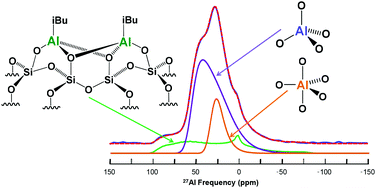Triisobutylaluminum: bulkier and yet more reactive towards silica surfaces than triethyl or trimethylaluminum†
Abstract

- This article is part of the themed collection: Molecular precursors for precision synthesis of nanomaterials
Maintenance work is planned for Wednesday 1st May 2024 from 9:00am to 11:00am (BST).
During this time, the performance of our website may be affected - searches may run slowly and some pages may be temporarily unavailable. If this happens, please try refreshing your web browser or try waiting two to three minutes before trying again.
We apologise for any inconvenience this might cause and thank you for your patience.
* Corresponding authors
a Laboratoire de Chimie Organometallique de Surface, CNRS, UMR 5265 C2P2, Universite Lyon 1, CPE Lyon, France
b
Universite de Lyon, CNRS, Institut de Chimie de Lyon, Ecole Normale Superieure de Lyon, 46 allee d'Italie, F-69364 Lyon Cedex 07, France
E-mail:
Philippe.Sautet@ens-lyon.fr
Tel: +33 47 272 8155
c
ETH Zurich, Department of Chemistry, Wolfgang-Pauli Strasse 10, CH-8093, Zurich, Switzerland
E-mail:
ccoperet@inorg.chem.ethz.ch
Tel: +41 44 633 9394
d CEMHTI CNRS UPR3079, Université d'Orléans, 1D Avenue de la Recherche-Scientifique, F-45071 Orléans Cedex 2, France

 Please wait while we load your content...
Something went wrong. Try again?
Please wait while we load your content...
Something went wrong. Try again?
A. Kermagoret, R. N. Kerber, M. P. Conley, E. Callens, P. Florian, D. Massiot, C. Copéret, F. Delbecq, X. Rozanska and P. Sautet, Dalton Trans., 2013, 42, 12681 DOI: 10.1039/C3DT51005K
To request permission to reproduce material from this article, please go to the Copyright Clearance Center request page.
If you are an author contributing to an RSC publication, you do not need to request permission provided correct acknowledgement is given.
If you are the author of this article, you do not need to request permission to reproduce figures and diagrams provided correct acknowledgement is given. If you want to reproduce the whole article in a third-party publication (excluding your thesis/dissertation for which permission is not required) please go to the Copyright Clearance Center request page.
Read more about how to correctly acknowledge RSC content.
 Fetching data from CrossRef.
Fetching data from CrossRef.
This may take some time to load.
Loading related content
